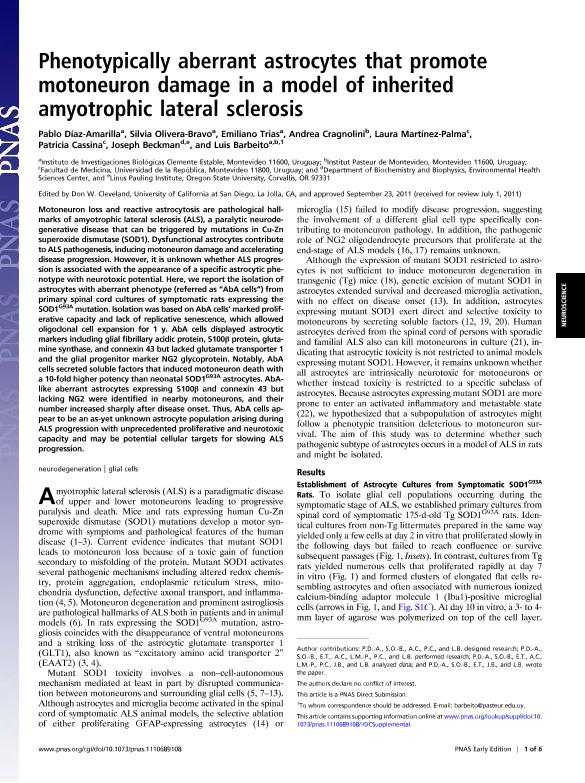Artículo
Phenotypically aberrant astrocytes that promote motoneuron damage in a model of inherited amyotrophic lateral sclerosis
Diaz Amarilla, Pablo; Olivera Bravo, Silvia; Trias, Emiliano; Cragnolini, Andrea Beatriz ; Martinez Palma, Laura; Cassina, Patricia; Beckman, Joseph; Barbeito, Luis
; Martinez Palma, Laura; Cassina, Patricia; Beckman, Joseph; Barbeito, Luis
 ; Martinez Palma, Laura; Cassina, Patricia; Beckman, Joseph; Barbeito, Luis
; Martinez Palma, Laura; Cassina, Patricia; Beckman, Joseph; Barbeito, Luis
Fecha de publicación:
01/11/2011
Editorial:
National Academy of Sciences
Revista:
Proceedings of the National Academy of Sciences of The United States of America
ISSN:
0027-8424
e-ISSN:
1091-6490
Idioma:
Inglés
Tipo de recurso:
Artículo publicado
Clasificación temática:
Resumen
Motoneuron loss and reactive astrocytosis are pathological hallmarks of amyotrophic lateral sclerosis (ALS), a paralytic neurodegenerative disease that can be triggered by mutations in Cu-Zn superoxide dismutase (SOD1). Dysfunctional astrocytes contribute to ALS pathogenesis, inducing motoneuron damage and accelerating disease progression. However, it is unknown whether ALS progression is associated with the appearance of a specific astrocytic phenotype with neurotoxic potential. Here, we report the isolation of astrocytes with aberrant phenotype (referred as “AbA cells”) from primary spinal cord cultures of symptomatic rats expressing the SOD1G93A mutation. Isolation was based on AbA cells’ marked proliferative capacity and lack of replicative senescence, which allowed oligoclonal cell expansion for 1 y. AbA cells displayed astrocytic markers including glial fibrillary acidic protein, S100β protein, glutamine synthase, and connexin 43 but lacked glutamate transporter 1 and the glial progenitor marker NG2 glycoprotein. Notably, AbA cells secreted soluble factors that induced motoneuron death with a 10-fold higher potency than neonatal SOD1G93A astrocytes. AbA-like aberrant astrocytes expressing S100β and connexin 43 but lacking NG2 were identified in nearby motoneurons, and their number increased sharply after disease onset. Thus, AbA cells appear to be an as-yet unknown astrocyte population arising during ALS progression with unprecedented proliferative and neurotoxic capacity and may be potential cellular targets for slowing ALS progression.
Palabras clave:
Astrocyte
,
Als
,
Spinal Cord
,
Motorneuron
Archivos asociados
Licencia
Identificadores
Colecciones
Articulos(IIBYT)
Articulos de INSTITUTO DE INVESTIGACIONES BIOLOGICAS Y TECNOLOGICAS
Articulos de INSTITUTO DE INVESTIGACIONES BIOLOGICAS Y TECNOLOGICAS
Citación
Diaz Amarilla, Pablo; Olivera Bravo, Silvia; Trias, Emiliano; Cragnolini, Andrea Beatriz; Martinez Palma, Laura; et al.; Phenotypically aberrant astrocytes that promote motoneuron damage in a model of inherited amyotrophic lateral sclerosis; National Academy of Sciences; Proceedings of the National Academy of Sciences of The United States of America; 108; 44; 1-11-2011; 18126-18131
Compartir
Altmétricas



